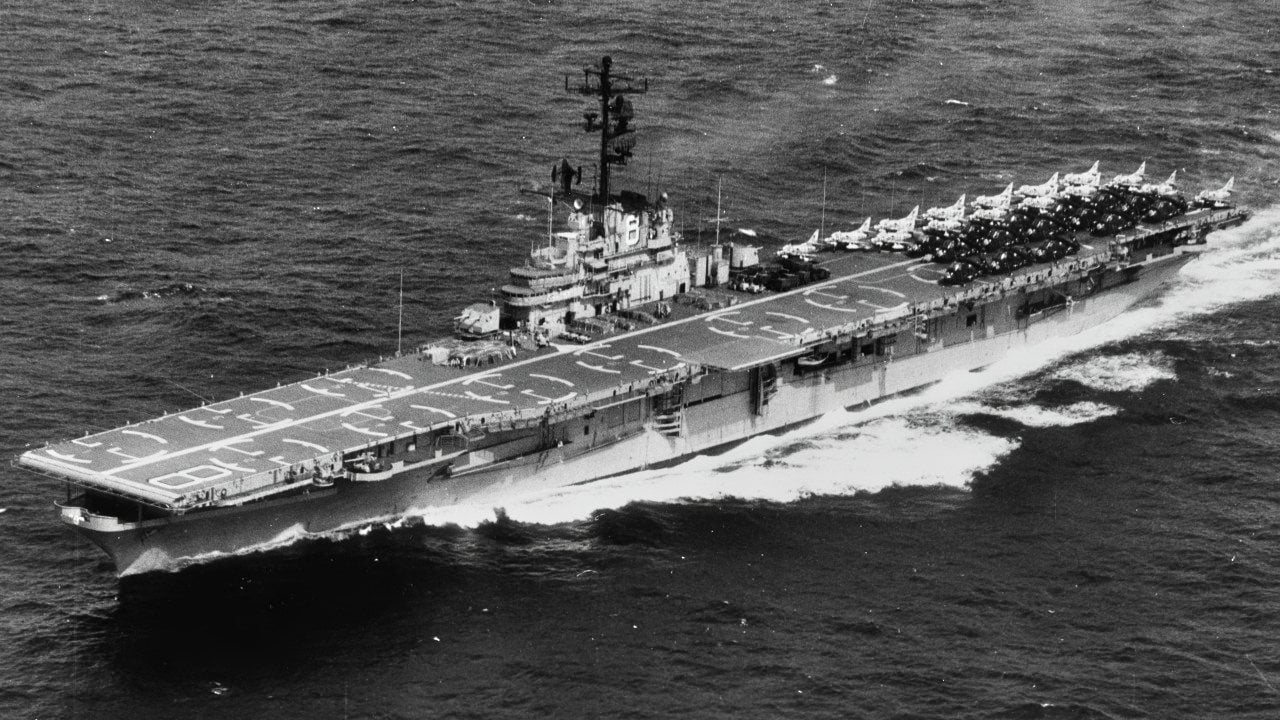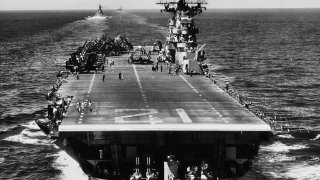Repeat After Me: The Essex-Class are the Best Aircraft Carriers Ever
The Essex-class aircraft carriers, commissioned during World War II, were pivotal in the U.S. Navy's success in the Pacific. Designed pragmatically to meet the immediate threats of the time, 24 of these carriers served with distinction in major battles like the Battle of the Philippine Sea.
Summary and Key Points: The Essex-class aircraft carriers, commissioned during World War II, were pivotal in the U.S. Navy's success in the Pacific. Designed pragmatically to meet the immediate threats of the time, 24 of these carriers served with distinction in major battles like the Battle of the Philippine Sea.

-They were highly versatile, relatively simple to maintain, and were produced in large numbers. The Essex-class' effectiveness and adaptability helped establish the aircraft carrier as a central component of naval power. Some experts consider them the best aircraft carriers ever put to sea.
-Reflecting on their history highlights the potential benefits of focusing on more cost-effective and easily maintainable carriers rather than today's highly complex and expensive "floating cities."
Essex-Class Aircraft Carriers: The Best Ever?
The Essex-class aircraft carrier, commissioned during the Second World War, represented a pinnacle of U.S. naval engineering at that time. This boat class served as the backbone of the U.S. Navy’s Fast Carrier Task Force in the Pacific.
The class consisted of 24 vessels, which came in both “short-hull” and “long-hull” versions. Thirty-two ships were originally ordered. As World War Two wound down, six of these boats were canceled, and two were canceled after construction had started.
The Situation Today
That’s a far cry away from where the country is today, as it is staring down the barrel of another world war—this time with a commodities superpower, Russia, an industrial giant, China, a regime in Iran that supports industrial-scale terrorism, and, possibly, a North Korea that can churn nukes out like sausages.
In fact, there is an image on Twitter/X that has gone viral. It is a picture of New York Harbor a year after the end of WWII. There are dozens of capital ships overflowing the harbor’s slips. There was such an abundance that most of them were being decommissioned—well before they needed to.
But that was then.
Today, the situation is much bleaker.
Every aircraft carrier is built to specification. They are massively expensive. Highly complex and require years of training to operate. If even one of these systems today is lost, it will create such a gap in America’s naval capabilities that it could cause the defeat of US forces in a given conflict.
What Made the Essex-class Great
Brilliantly, the Essex-class carriers were designed to meet the threat of their time (notably the Imperial Japanese Navy). These systems were not built to “anticipate tomorrow’s wars today.” Instead, America pragmatically built the systems it needed to fight—and win—the wars it was actually fighting.
These carriers were equipped with numerous quad 40mm Bofors and twin 20mm Oerlikon cannons. The armament of the Essex-class was perfectly tailored to overcoming threats posed to the fleet by the Axis Powers at sea.
America’s Essex-class aircraft carriers were a testament to the ongoing evolution of naval engineering and the growing importance of naval aviation in modern warfare. It has been said that necessity is the mother invention and desperation is its father. How fitting for the aircraft carrier, which was always viewed as the proverbial redheaded stepchild of the US Navy during the Interwar Years, when the battleship was the pinnacle of naval surface warfare capabilities.
Pearl Harbor and decimation of America’s Pacific Fleet forced about significant changes to the US fleet—not because the military wanted to change (what bloated bureaucracy does?) but because they were forced to out necessity and desperation. The importance of the aircraft carrier in winning the Pacific Theater of the Second World War cannot be overstated.
Indeed, at that time, it was the sine qua non for victory over the Japanese Empire (which, despite its understandable focus on the Nazi threat, Japan was the more direct military threat facing the Americans and the US Navy, with its carriers, was well-suited to counteract that challenge once the war began).
Some Facts About the Essex-class
The Essex-class had a standard displacement of 27,000 tons (41,200 tons when fully loaded) and an approximate length of 872 feet.
From the moment they were commissioned, the Essex-class carriers were thrust into the crucible of combat in the Pacific Theater. One of the crowning achievements of the Essex-class occurred during the Battle of the Philippine Sea in June 1944. This was one of the largest carrier-to-carrier battles in history. And the Yanks defeated their Japanese rivals decisively (hence “Turkey Shoot” being used to describe this event).
The first five Essex-class carriers were laid down by New York Shipbuilding of Camden, New Jersey, in 1941. The versatility, longevity—and relative simplicity—of the Essex-class led to it being dubbed the “DC-3 of aircraft carriers” by its admirers. An astonishing 24 units were delivered from 1943-1950, and it remains the most-produced fleet carrier design of all time, with the last one being retired in 1991.
Essex-class carriers served in three wars during a career that began with operating propeller planes before adapting to the advent of jet aircraft and ending its run for the Navy in the space age. The success of the Essex-class contributed to the ascendance of the flat top as the capital ship of the US Navy.
Unfortunately, the Navy never got the messages that a) enemies adapt and b) the reason for the ubiquity of the Essex-class carriers was because of their aforementioned low-cost, simple design, and easy maintenance (compared to nuclear-powered carriers today).
Maybe We Should Learn from Our History…
If America at least abandoned its obsession with building “floating cities” and instead invested in significantly pared down carriers, we’d all be better off. Alas, the defense contractors who run the capital won’t hear of it. And, frankly, everyone in government—from elected leaders to admirals—love being able to point to the aircraft carrier as the ultimate symbol of US military power projection.
America’s Essex-class carrier will go down in history as the single-greatest class of aircraft carrier ever built. Because it had so many units in its class, there were multiple legendary warships that were of the Essex-class. Some of these famous ships include the USS Essex (CV-9), the namesake of the class, USS Yorktown (CV-10), USS Hornet (CV-12), USS Franklin (CV-13), USS Lexington (CV-16), USS Bunker Hill (CV-17), USS Intrepid (CV-11), and USS Wasp (CV-18).
All the carriers listed above served the US Navy with distinction and participated in famous battles, like the aforementioned Battle of the Philippine Sea, the Battle of Leyte Gulf, and the Battle of Okinawa. We will never forget the incredible service of this class. And, let us hope that our leaders realize why the aircraft carrier will never be able to serve the way they did in WW2 when World War III erupts.
Author Experience and Expertise: Brandon J. Weichert
Brandon J. Weichert, a National Interest national security analyst, is a former Congressional staffer and geopolitical analyst who is a contributor at The Washington Times, the Asia Times, and The-Pipeline. He is the author of Winning Space: How America Remains a Superpower, Biohacked: China’s Race to Control Life, and The Shadow War: Iran’s Quest for Supremacy. His next book, A Disaster of Our Own Making: How the West Lost Ukraine, is due October 22 from Encounter Books. Weichert can be followed via Twitter @WeTheBrandon.
All images are Creative Commons or Shutterstock.
From the Vault
Russia Freaked Out: Why the U.S. Navy 'Unretired' the Iowa-Class Battleships
Battleship vs. Battlecruiser: Iowa-Class vs. Russia's Kirov-Class (Who Wins?)


